Invisalign – Washington, DC
Clear Braces - Clearly Beautiful Smiles
As a teenager, you may have been relieved that you didn’t have to undergo traumatically embarrassing tooth alignment using traditional braces, but as an adult, you might be looking at your crowded or gapped teeth wishing you had. While getting braces might have seemed embarrassing at the time, you realize in retrospect that more than half of your friends had them. As an adult, this is probably not the case. You want to correct your bite misalignment because you know a straighter smile helps prevent bacterial buildup in crowded dental areas, and uneven wearing of your teeth, but the thought of wearing braces to your upcoming business meeting is preventing you from taking the next step. If this sounds familiar, you may want to consider smile alignment with Invisalign from our Washington, DC cosmetic dentist.

Why Choose Aesthetic & Family Dentistry of Washington for Invisalign?
- Discreet Invisalign Treatment
- Orthodontics for Teens & Adults
- Experienced Team of Dentists
Invisalign® Clear Braces

At Aesthetic & Family Dentistry of Washington, we know just how you feel. That’s why we offer Invisalign in Washington, DC. These clear braces work to straighten your teeth in less time, with less pain, and none of the metallic smiles that go along with traditional braces. It’s an effective way to get a corrected bite without missing a beat.
Living with Invisalign Aligners
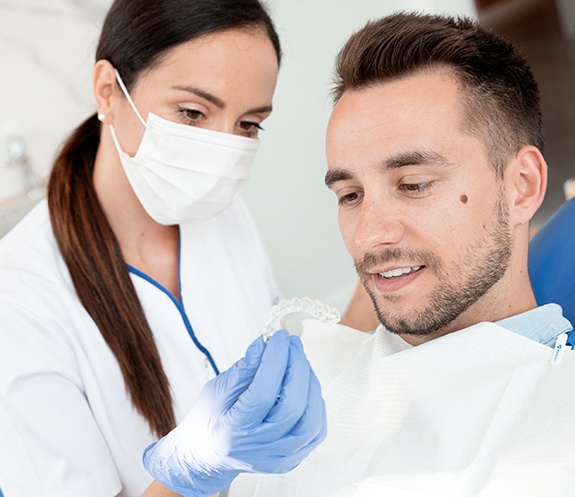
At this point, you know quite a bit about Invisalign – from what the trays look like to some of the perks that come with clear aligners. But what does life with Invisalign look like? If you’ve been asking yourself that question, this next section is for you!
Wearing Your Trays
Once your aligners are created, you’ll simply place them on your teeth, and your orthodontic treatment will officially begin! To stay on-track with your plan, we recommend wearing them for a minimum of 20 hours a day. Then, after 7-14 days, you’ll progress to the next set in the series. To avoid frustrating treatment plan delays, it’s of the utmost importance that you meet the daily wear time and that you switch to each new set on the correct day.
Cleaning Your Aligners
Caring for your Invisalign aligners is crucial. Otherwise, they will start to stain and develop an unpleasant odor! The good news is that you don’t need anything special. In fact, you can continue with the at-home dental hygiene routine you’re used to with the addition of gently brushing your alignment trays whenever you brush your teeth.
Tip: If you need to wear your aligners longer than anticipated, use the cleaning crystals that came in your welcome kit to give them a deeper clean.
Eating & Drinking
Because they’re removable, Invisalign can be taken out during meals. As a result, you don’t need to give up any of your favorite foods while you straighten your teeth! All we ask is that you exercise caution with crunchy foods, like hard pretzels, that have the potential to break an attachment. It’s also a good idea to limit your intake of sugary and starchy foods since they increase your risk of common oral health problems, like cavities.
Losing or Damaging a Tray
At first, losing and damaging a tray may seem like two completely different situations. However, they both can lead to significant treatment plan delays. So, it’s important that you act fast! If you lost one of your aligners, try carefully retracing your steps to see if you can find it. If your attempts are unsuccessful, then call us ASAP. Over the phone, we can determine if it’s safe to move on or if you need to wear your previous set while a replacement is made.
Attending Routine Check-Ins
Periodically, you will need to visit our dental office to ensure your teeth and bite are aligning in accordance with your treatment plan. The good news is that you will need about half as many of these appointments compared to traditional braces, and they will not take nearly as long. In short, you’ll spend less time in the treatment chair and more time with family and loved ones.
Who Can Invisalign Help?
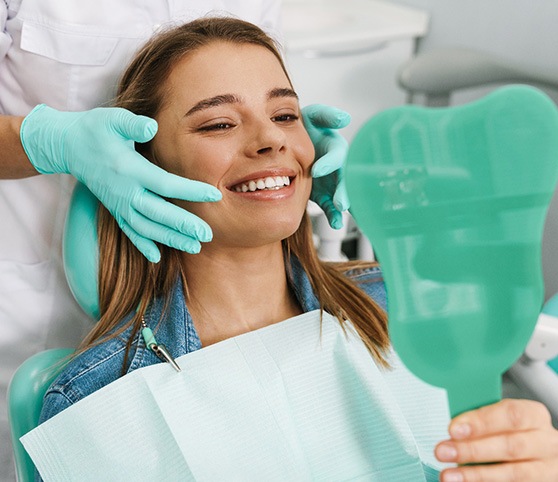
Whether you’re a teen or an adult, you might be deterred by the idea of wearing metal brackets and wires. Fortunately, Invisalign is virtually undetectable and incredibly versatile. Below, you’ll find a few of the orthodontic problems that clear aligner treatment can correct. You can also give us a call to schedule a consultation and find out if you’re a candidate!
Crowded Teeth
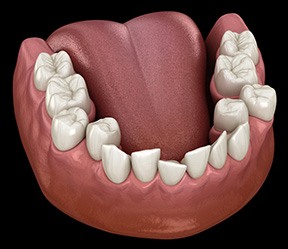
Simply put, if there isn’t enough room in your mouth for your teeth to sit in their perfectly aligned positions, they will crowd together instead. Not only does this negatively impact the look of your smile, but it also makes it difficult for your toothbrush and floss to remove harmful plaque and tartar. In other words, you should explore your orthodontic treatment options for the sake of the appearance and health of your smile!
Gaps Between Teeth

While some patients have several small spaces throughout their smile, others have one large gap between their two front teeth. Whatever the case may be for you, you’ll be happy to know that Invisalign has proven to be effective at correcting mild or moderate cases of this orthodontic problem in the past – all with clear, comfortable, and custom-made aligners. So, what are you waiting for? Schedule your consultation today!
Overbite
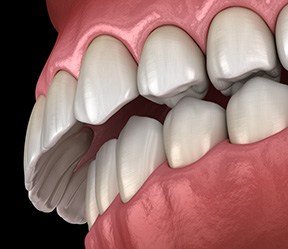
There’s a common misconception that Invisalign can only straighten teeth. That’s not the case; they can improve the alignment of your bite too! So, if your upper teeth jut out beyond your lower ones to the point where it’s negatively impacting your chewing and speaking patterns, it’s time to schedule an appointment at our Washington, DC office. Once we conduct a comprehensive oral exam and know more about your smile goals, we can determine if Invisalign is right for you.
Underbite
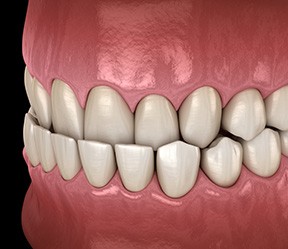
If you have the opposite problem (your lower teeth sit in front of your upper teeth), then you know all too well the discomfort that comes with an underbite. In fact, it’s very common for patients to experience chronic jaw pain as well as several other issues, including premature wear and tear on their teeth. For that reason, we strongly recommend coming to our office to explore your treatment options. If Invisalign is right for you, then we will address your underbite with a series of clear aligners.
Crossbite
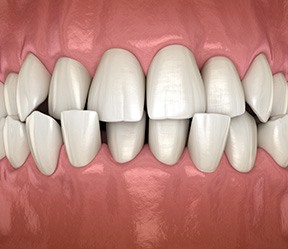
As you may have guessed from the name, crossbites are when some of the lower teeth sit in front of the upper teeth, resulting in a mixed bite. Fortunately, like the other orthodontic problems on this list, Invisalign is suitable for mild to moderate cases. Sometimes, this requires rubber bands, buttons, and other orthodontic accessories. Rest assured, your journey to a straight, healthy, and beautiful smile will still be considerably more discreet than if you had traditional braces.
Open Bite
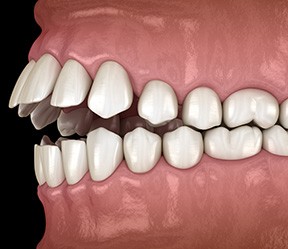
When you bite down, your teeth should come together evenly. If they don’t because there is space in the front or back of your mouth, then chances are that you have an open bite. We recommend coming to our office to find out if you’re a candidate for Invisalign sooner rather than later. That way, we can align your bite before you run into any issues, like premature wear and tear on your teeth.
Invisalign FAQs
How Long Does Invisalign Take?
It generally takes between 12 to 18 months to complete Invisalign treatment, although it could be more or less, depending on a few different factors. For example, if you have mild misalignments and your teeth shift as quickly as intended, then it might only take 6 months. If you have more severe issues then it could take up to 2 years, which is still less time than it takes with traditional braces. Also, if you don’t wear your aligners for 22 hours every day then your teeth could revert to their previous placements which will delay your treatment timeline.
Does Invisalign Hurt?
Invisalign is not considered a painful treatment, especially when compared to traditional orthodontics. However, anything that exerts enough pressure on your teeth to move them has the potential to cause discomfort. It’s natural to feel some soreness and tenderness when you receive your new trays until your mouth has adjusted to wearing them.
Fortunately, any aching is usually mild and resolves itself in a few days. In the meantime, you can apply a cold compress or take over-the-counter medications like Tylenol or ibuprofen for a reprieve. If you find that it doesn’t go away or only gets worse, then contact us so we can ensure that your Invisalign fits as intended.
Does Invisalign Give You a Lisp?
Invisalign uses clear plastic trays that fit snuggly over your teeth to reposition them which causes your teeth to rest differently when they come together. It’s not uncommon to have an initial adjustment period while your tongue and mouth learn to work around them to form all the right sounds and words. You might develop a mild lisp during this time, but it typically only lasts a few weeks at the most. Other patients are unaffected and don’t experience any changes to their speech at all.
If you do have challenges at first, one of the best ways to get through them is to practice. Speaking frequently allows your tongue to adjust more quickly.
How Do I Clean My Invisalign?
You’ll need to care for your aligners properly for them to continue doing their job. Some tips for keeping them in good shape include:
- Remove them for meals and rinse them (and your mouth) with water before putting them back in.
- Take them out to brush them with a soft-bristled toothbrush twice daily to remove unwanted bacteria and plaque buildup.
- Soak them each day with Invisalign cleaning crystals to dissolve up to 99% of germs.
- Brush and floss your teeth thoroughly twice daily so you’re putting your trays into a clean mouth.
- Remember not to expose your aligners to hot water because it can warp or crack them.
